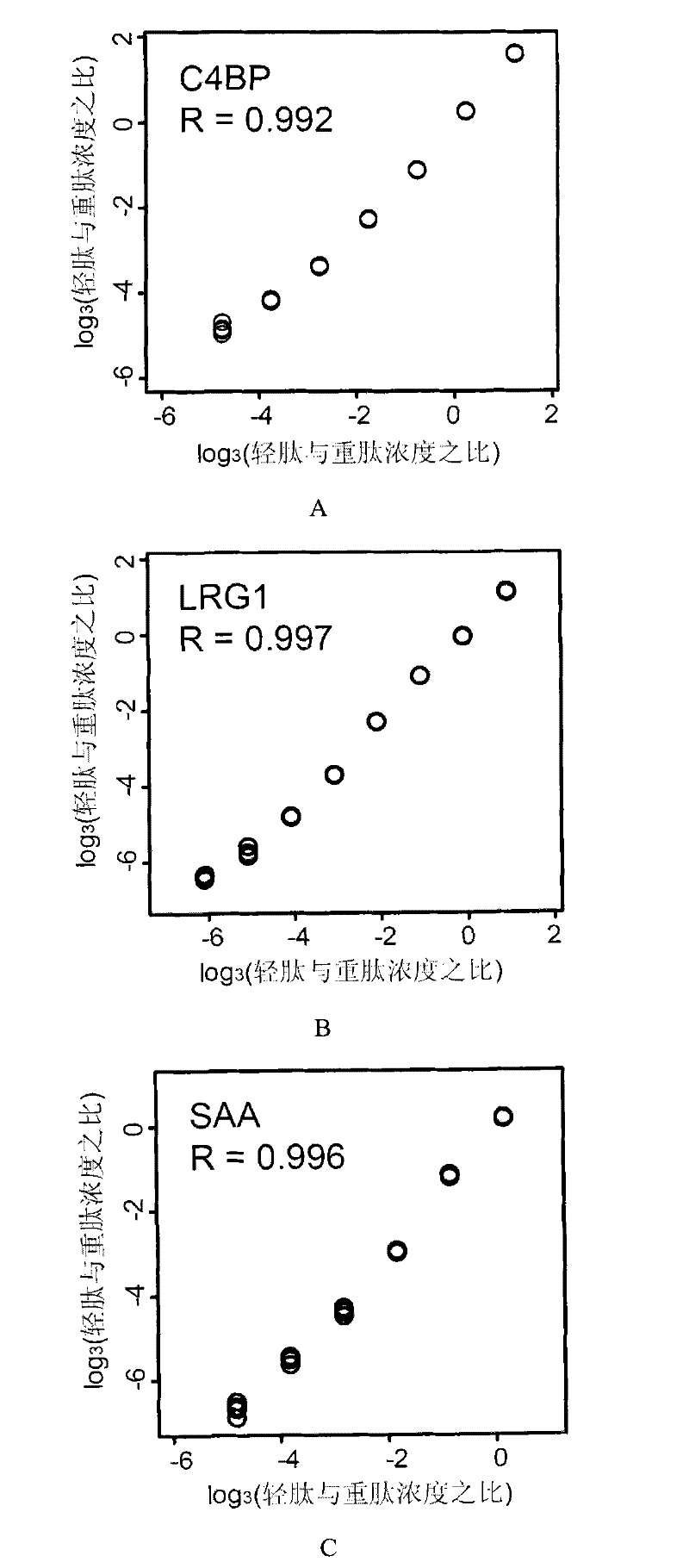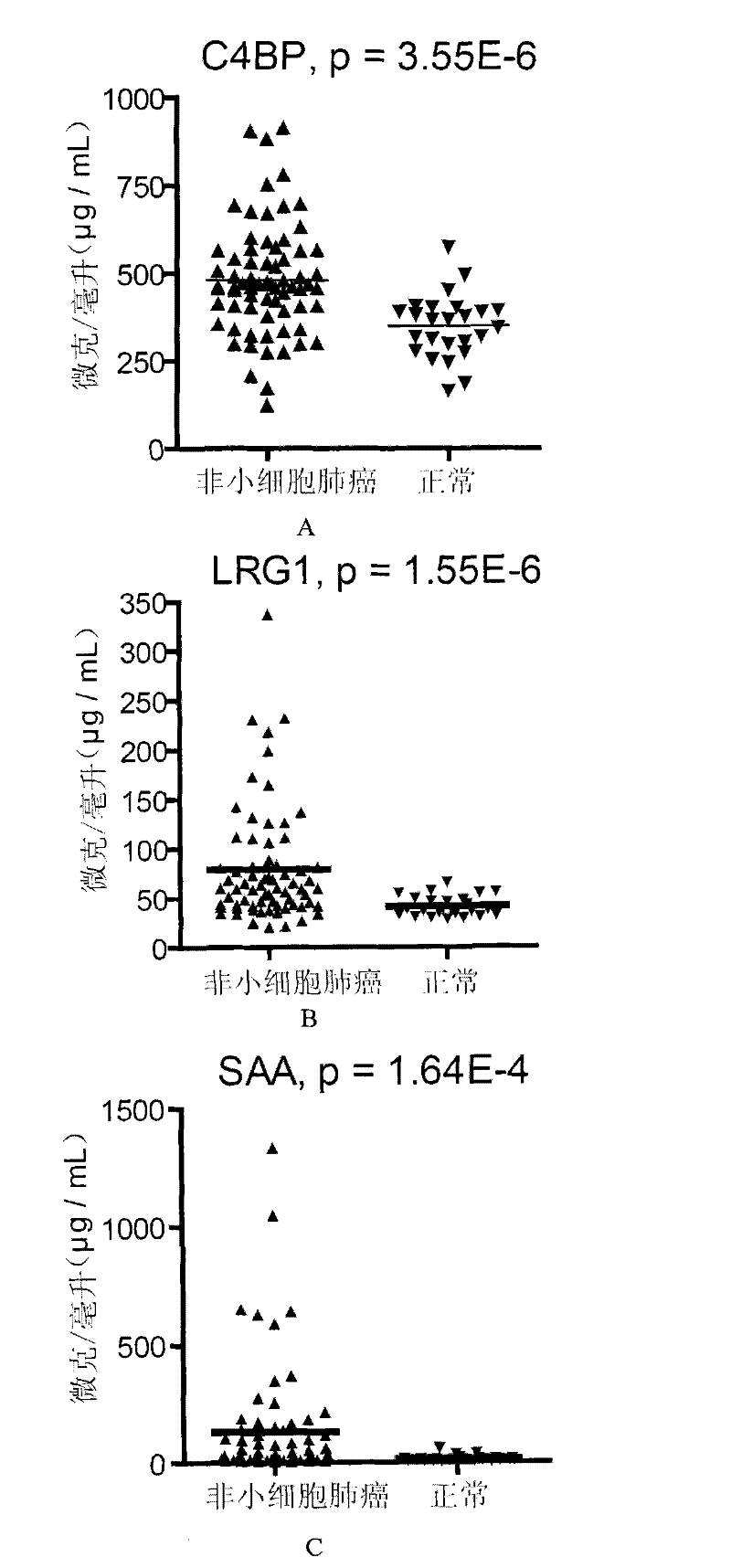Non-small cell lung cancer molecular marker and its application
A non-small cell lung cancer, isotope labeling technology, applied in the biological field, can solve the problems of low early diagnosis rate and unclear reasons for recurrence
- Summary
- Abstract
- Description
- Claims
- Application Information
AI Technical Summary
Problems solved by technology
Method used
Image
Examples
Embodiment 1
[0048] Example 1. Treatment of blood samples from patients with non-small cell lung cancer and normal control blood samples and preparation of peptides
[0049] The urea used in this example, 3-[(3-cholamidopropyl)-diethylammonium]-1-propanesulfonic acid (CHAPS), sodium dodecylsulfonate (SDS), dithiothreose Alcohol (DTT) and 4-hydroxyethylpiperazineethanesulfonic acid (HEPES) were purchased from Bio-Rad.
[0050] Blood from patients newly diagnosed with adenocarcinoma (lung adenocarcinoma, AD) or squamous cell carcinoma (squamous cellcarcinoma, SCC) (collected before treatment), and normal controls were collected. The specific information of the samples is shown in Table 1, Table 2 and Table 3 respectively. Among them, the 20 pairs of samples in Table 1 were paired according to factors such as gender, age, smoking status, and TNM stage. The MRM data of these samples were used for the prognosis analysis of lung squamous cell carcinoma. Table 2 shows the information of another...
Embodiment 2
[0065] Example 2, online integrated column chromatography fractionation, liquid chromatography tandem mass spectrometry analysis, protein identification and data analysis
[0066] The method of online integrated column chromatography fractionation and liquid chromatography tandem mass spectrometry is as follows: 11 pH gradients are used for fractionation on a strong cation exchange column (Column Technology Company). Then further fractionation on the reverse phase column (ColumnTechnology company), the mobile phase is 0.1% formic acid (v / v) solution (solution A) and 0.1% formic acid / acetonitrile (v / v) solution (solution B), within 115 minutes the solution B increased from 2% to 40%, detected on LTQ mass spectrometer (Thermo Finnigan).
[0067] The mass spectrometry data was searched by SEQUEST software in the International Protein Index (IPI) database (version number 3.22), and then used the Buildsummary software of our laboratory to search the positive and negative libraries ...
Embodiment 3
[0071] Example 3, Peptide Screening, Synthesis and Optimization of Detection Conditions for Transition and Quantitative Performance Analysis
[0072] According to the results of Example 2, combined with the screening criteria of peptides, the candidate peptides and Transition corresponding to the three proteins were determined. Then use the optimizer software of Agilent to optimize the experimental conditions of Transition, and at the same time select Transition with better signal intensity for protein quantification. The results are shown in Table 4. The corresponding coefficient of variation was calculated by performing 5 experimental repetitions on the mixed peptide samples, and the results are shown in Table 4.
[0073] Isotope-labeled Heavy Peptides 13 C-labeled leucine ([13C6]Leucine) and alanine ([13C3]Alanine), purchased from Sigma-Aldrich) and unlabeled light-labeled peptides were synthesized by Gil Biochemical (Shanghai) Co., Ltd., purity >95%.
[0074] Then dete...
PUM
 Login to View More
Login to View More Abstract
Description
Claims
Application Information
 Login to View More
Login to View More - R&D
- Intellectual Property
- Life Sciences
- Materials
- Tech Scout
- Unparalleled Data Quality
- Higher Quality Content
- 60% Fewer Hallucinations
Browse by: Latest US Patents, China's latest patents, Technical Efficacy Thesaurus, Application Domain, Technology Topic, Popular Technical Reports.
© 2025 PatSnap. All rights reserved.Legal|Privacy policy|Modern Slavery Act Transparency Statement|Sitemap|About US| Contact US: help@patsnap.com



